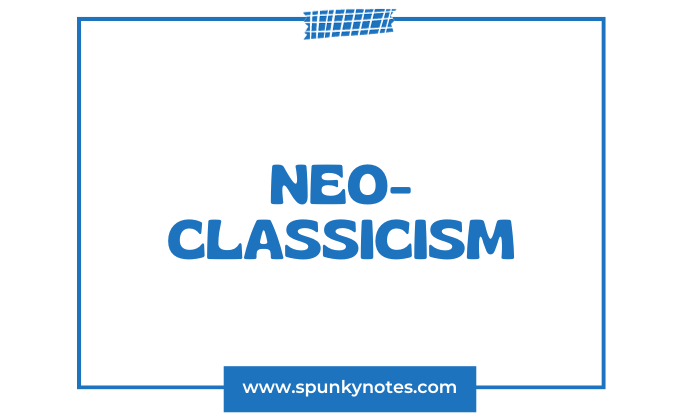

Estimated Reading Time: 8 min
Q. Write a note on Neoclassicism.
Neoclassicism
The term “neoclassicism” is made up of two parts:
Neo: A prefix meaning “new” or “revived.”
The prefix “neo-” comes from the Greek word “neos,” which means “new” or “young.” It is used in English and many other languages to form words that refer to a new or revived form of something.
Classicism refers to the principles and styles associated with the culture, art, and literature of ancient Greek and Roman society.
When combined, “neoclassicism” describes the revival or new adoption of classical thought, aesthetics, and principles. This movement sought to bring back the artistic ideals of the ancient world in a newer context, emphasizing qualities like symmetry, simplicity, and a sense of order.
Neoclassicism started around the 1750s. It was a way for artists to return to ancient Greece and Rome’s simple and clear art.
Neoclassicism was a way for artists, writers, and thinkers to reconnect with the values of classical antiquity, seen as a golden age of rationality, decorum, and harmony.
Johann Joachim Winckelmann was significant in starting this movement because he loved the clear style of old art and told others about it.
People got even more interested in this old-style art when they found the ancient cities of Pompeii and Herculaneum, which had been buried by a volcano long ago.
These cities had lots of old art and buildings that were well preserved. Also, during this time, many wealthy young men would travel around Europe to see art and learn, and they brought back a love for the old styles.
This new, old-fashioned style became popular because it was simple, balanced, profound, and vital. Artists and builders started making less complicated things and more about the basics, which they thought were better and more beautiful.
Johann Joachim Winckelmann
- Date of Birth: December 9, 1717
- Place of Birth: Stendal, Prussia (Germany)
- Date of Death: June 8, 1768
- Occupation: Art Historian and Archaeologist
- Expertise: Winckelmann was an expert in ancient Greek and Roman art.
Contribution to Neoclassicism: His writings, particularly “History of Ancient Art,” inspired the Neoclassical movement. He encouraged modern artists to follow the example of the ancient Greeks and Romans, focusing on simplicity and elegance in art.
Neoclassicism in Literature
Neoclassicism was a time in literature when writers copied the simple and smart style of old Greek and Roman works. They liked rules, clear writing, and stories that taught lessons about how to live well.
They made fun of silly or bad societal things to make people think and do better. This style was widespread from the late 1600s to the early 1800s until Romanticism came along and brought back interest in emotions and the imagination.
Key Neoclassical Writers
- Alexander Pope
- Jonathan Swift
- Voltaire
- Samuel Johnson
- Gotthold Ephraim Lessing
1- Alexander Pope
- Date of Birth: May 21, 1688
- Date of Death: May 30, 1744
- Place of Birth: London, England
- Occupation: He was a poet known for his brilliant use of the heroic couplet and sharp wit.
Contribution to Neoclassicism: Pope’s poetry exemplified Neoclassical ideals, advocating for order and against emotional excess. His mock-epic “The Rape of the Lock” satirizes petty aristocratic society using classical epics as a model, showcasing his alignment with Neoclassical aesthetics.
2- Jonathan Swift
- Date of Birth: November 30, 1667
- Date of Death: October 19, 1745
- Place of Birth: Dublin, Ireland
- Occupation: He was a writer and satirist known for his essays, political pamphlets, and innovative narrative techniques.
Contribution to Neoclassicism: Swift’s irony and moral critique, particularly in “A Modest Proposal” and “Gulliver’s Travels,” align with the Neoclassical pursuit of societal reform through literature. His work combines classical structures with a contemporary edge, embodying the Neoclassical era’s intellectual vigor.
3- Voltaire (François-Marie Arouet)
- Date of Birth: November 21, 1694
- Date of Death: May 30, 1778
- Place of Birth: Paris, France
- Occupation: He was a renowned philosopher, playwright, and writer celebrated for advocating freedom of speech and religion.
Contribution to Neoclassicism: Voltaire’s sharp criticism of the establishment and advocacy for civil liberties align with Neoclassical thought, which favored reason over superstition.
His plays and essays are marked by their clever use of classical form to deliver cutting-edge social commentary.
4- Samuel Johnson
- Date of Birth: September 18, 1709
- Date of Death: December 13, 1784
- Place of Birth: Lichfield, Staffordshire, England
- Occupation: He was a lexicographer, critic, and moralist whose work has impacted English literature and language.
Contribution to Neoclassicism: Johnson’s dictionary standardized the English language and literature, while his essays and biographies enforced the Neoclassical doctrines of morality, balance, and reason. He was a moral authority and a promoter of the disciplined use of language.
5- Gotthold Ephraim Lessing
- Date of Birth: January 22, 1729
- Date of Death: February 15, 1781
- Place of Birth: Kamenz, Saxony, Germany
- Occupation: He was a playwright, art critic, and philosopher, instrumental in developing German literature.
Contribution to Neoclassicism: Lessing’s plays and his theoretical works, like “Hamburg Dramaturgy,” stress the importance of emotional restraint and intellectual clarity.
His advocacy for the separation of painting and poetry, based on classical models, reflects his commitment to the distinctiveness and purity of artistic forms, a central tenet of Neoclassicism.
Neoclassicism in Art
Neoclassicism in art and architecture was about returning to the clean and strong styles from long ago in Greece and Rome. Artists like Jacques-Louis David made paintings with clear lines and calm colors, showing stories from history and myths.
Architects designed buildings with straight columns and big domes, making them look grand and tidy, like the old temples and public places.
His style was trendy because people wanted buildings and art that felt timeless, serious, and meaningful. It was a significant change from the earlier styles, which were more about decoration and fancy details.
1- Jacques-Louis David
- Date of Birth: August 30, 1748
- Date of Death: December 29, 1825
- Place of Birth: Paris, France
- Occupation: Painter
David was a leading French painter in the Neoclassical style. His art often had strong storytelling elements, focusing on classical subjects and emphasizing moral virtue and stoicism. His famous painting “The Death of Socrates” embodies the Neoclassical ideals of reason and civic duty.
2- Jean-Auguste-Dominique Ingres
- Date of Birth: August 29, 1780
- Date of Death: January 14, 1867
- Place of Birth: Montauban, France
- Occupation: Painter
Ingres was known for his precision and clarity, key traits of Neoclassical art. His portraits and historical paintings, like “Napoleon I on His Imperial Throne,” are praised for their linearity and refined elegance, showcasing a return to classical refinement.
3- Antonio Canova
- Date of Birth: November 1, 1757
- Date of Death: October 13, 1822
- Place of Birth: Possagno, Republic of Venice
- Occupation: Sculptor
Canova was an Italian sculptor whose work revived classical sculpture with works like “Venus Victrix.” His ability to capture the grace and serenity of the classical spirit in marble made him a pivotal figure in Neoclassical art.
Neoclassicism in Music
Neoclassical music took cues from ancient Greece and Rome, focusing on clear, logical, and balanced compositions—Christoph Willibald Gluck streamlined opera for stronger emotional impact.
Luigi Boccherini brought elegance to chamber music with structured harmonies. Muzio Clementi’s piano sonatas highlighted form and clarity, elevating the piano in classical music.
These composers sought to create timeless, emotionally resonant works by stripping back complexity in favor of purity and simplicity.
1- Christoph Willibald Gluck
- Date of Birth: July 2, 1714
- Date of Death: November 15, 1787
- Occupation: Composer
Contribution to Neoclassicism: Gluck made operas easier to understand and more focused. He believed music should show the story and feelings without unnecessary show-offs.
His opera “Orfeo ed Euridice” is an excellent example of this. He made the music express the action straightforwardly, which was a big part of Neoclassicism—getting back to basics and expressing genuine feelings.
2- Luigi Boccherini
- Date of Birth: February 19, 1743
- Date of Death: May 28, 1805
- Occupation: Composer and Cellist
Contribution to Neoclassicism: Boccherini is known for music that sounds neat and balanced. He wrote many pieces for small groups of instruments, like two violins, a viola, and two cellos.
This kind of music is called chamber music. It is calm and orderly, fitting Neoclassicism’s love for clear and well-put-together things. People still listen to his music today because it is beautiful and does not try too hard.
Muzio Clementi
- Date of Birth: January 23, 1752
- Date of Death: March 10, 1832
- Occupation: Composer, Pianist, and more
Contribution to Neoclassicism: Clementi’s piano music helped shape how piano music was written. He focused on making the music clear and well-organized. He was famous for his sonatas, which are solo piano pieces with different parts or movements.
Each movement has its mood and style, but they all fit together. His music made the piano necessary in classical music and showed off what it could do.
In short, these three guys helped make music about returning to the basics—strong, clear sounds with no fuss. They wanted to make music that would last, about real feelings, and that did not get lost in too much decoration.
They were part of Neoclassicism, which was all about looking back at ancient Greece and Rome and trying to make art and music that were just as good.


